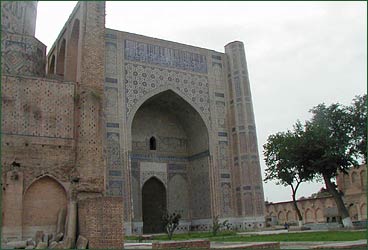|
|
 |
 |
 |
 |
Tourism |
 |
 |
 |
Samarkand - Bibi Khanim
|
 |
<<
1
2
3
4
5
6
7
8
9
10
11
12
13
14
15
>>
|
 |
Another outstanding architectural construction of medieval Samarkand is the main mosque Bibi-Khanim. Its construction began in 1399, after Timur's victorious campaign on India. The mosque had been constructed in five years. By Timur's plan the mosque Bibi-Khanim was supposed to eclipse all that he saw in other countries. The architects, artists, foremen and craftsmen from many countries of the East were involved in construction. Two hundred stone-carvers from Azerbaijan, Fars, Indostan and other countries worked in the mosque and five hundred workers in the mountains near Penjikent, extracting and carving the stones and sending them to Samarkand.

Bibi Khanim
The construction was not yet completed, when Timur again set off for one of his campaigns. After returning to the capital, he went immediately to look on the new mosque. The grandiose buildings occupied a rectangular court yard of 130x102 meters. On its western side towered the main mosque, on the northern and southern - small mosques. The spacious internal courtyard was covered with marble plates and enclosed with covered gallery for devout. The entrance to the courtyard was designed as a high portal with two round minarets fifty meters high. The facade of the main mosque was also decorated with majestic portal with two minarets.
The walls of all premises were richly decorated from outside with multi-colored glazed bricks which formed whimsical geometrical ornament and religious sayings. The magnificent and rich furnishing of internal premises consists of facing with glazed mosaic, carved marble and gilt patterns. However, Timur was dissatisfied by construction and in anger ordered to seize the nobles - Hodja Mahmud David and Muhammad Jeld, who were supervising construction. They were sentenced to death and hung up behind the channel Siab, at the foot of Chupanata.
|
 |
|
 |
|
 |
 |

